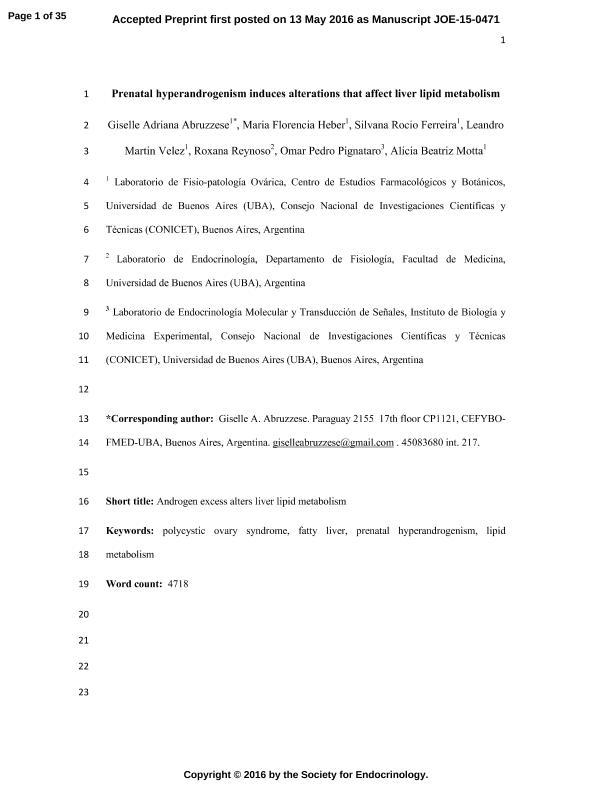Artículo
Prenatal hyperandrogenism induces alterations that affect liver lipid metabolism
Abruzzese, Giselle Adriana ; Heber, María Florencia
; Heber, María Florencia ; Ferreira, Silvana Rocío; Velez, Leandro Martin
; Ferreira, Silvana Rocío; Velez, Leandro Martin ; Reynoso, Roxana María; Pignataro, Omar Pedro
; Reynoso, Roxana María; Pignataro, Omar Pedro ; Motta, Alicia Beatriz
; Motta, Alicia Beatriz
 ; Heber, María Florencia
; Heber, María Florencia ; Ferreira, Silvana Rocío; Velez, Leandro Martin
; Ferreira, Silvana Rocío; Velez, Leandro Martin ; Reynoso, Roxana María; Pignataro, Omar Pedro
; Reynoso, Roxana María; Pignataro, Omar Pedro ; Motta, Alicia Beatriz
; Motta, Alicia Beatriz
Fecha de publicación:
01/07/2016
Editorial:
Society for Endocrinology
Revista:
Journal of Endocrinology
ISSN:
0022-0795
e-ISSN:
1479-6805
Idioma:
Inglés
Tipo de recurso:
Artículo publicado
Clasificación temática:
Resumen
Prenatal hyperandrogenism is hypothesized as one of the main factors contributing to26 the development of polycystic ovary syndrome (PCOS). PCOS patients have high risk27 of developing fatty liver and steatosis. This study aimed to evaluate the role of prenatal28 hyperandrogenism in liver lipid metabolism and fatty liver development. Pregnant rats29 were hyperandrogenized with testosterone. At pubertal age, the prenatally30 hyperandrogenized (PH) female offspring displayed both ovulatory (PHov) and31 anovulatory (PHanov) phenotypes that mimic human PCOS features. We evaluated32 hepatic transferases, liver lipid content, the balance between lipogenesis and fatty acid33 oxidation pathway, oxidant/antioxidant balance and pro-inflammatory status. We also34 evaluated the general metabolic status through growth rate curve, basal glucose and35 insulin levels, glucose tolerance test, HOMA-IR index and serum lipid profile.36 Although neither PH group showed signs of liver lipid content, the lipogenesis and fatty37 oxidation pathways were altered. The PH groups also showed impaired38 oxidant/antioxidant balance, a decrease in the pro-inflammatory pathway (measured by39 prostaglandin E2 and cyclooxygenase-2 levels), decreased glucose tolerance, imbalance40 of circulating lipids and increased risk of metabolic syndrome. We conclude that41 prenatal hyperandrogenism generates both PHov and PHanov phenotypes with signs of42 liver alterations, imbalance in lipid metabolism and increased risk of developing43 metabolic syndrome. The anovulatory phenotype showed more alterations in liver44 lipogenesis and a more impaired balance of insulin and glucose metabolism, being more45 susceptible to the development of steatosis.
Palabras clave:
Hyperandrogenism
,
Lipid Metabolism
,
Polycystic Ovary Syndrome
,
Lipids
Archivos asociados
Licencia
Identificadores
Colecciones
Articulos(IBYME)
Articulos de INST.DE BIOLOGIA Y MEDICINA EXPERIMENTAL (I)
Articulos de INST.DE BIOLOGIA Y MEDICINA EXPERIMENTAL (I)
Citación
Abruzzese, Giselle Adriana; Heber, María Florencia; Ferreira, Silvana Rocío; Velez, Leandro Martin; Reynoso, Roxana María; et al.; Prenatal hyperandrogenism induces alterations that affect liver lipid metabolism; Society for Endocrinology; Journal of Endocrinology; 230; 1-7-2016; 67-79
Compartir
Altmétricas



